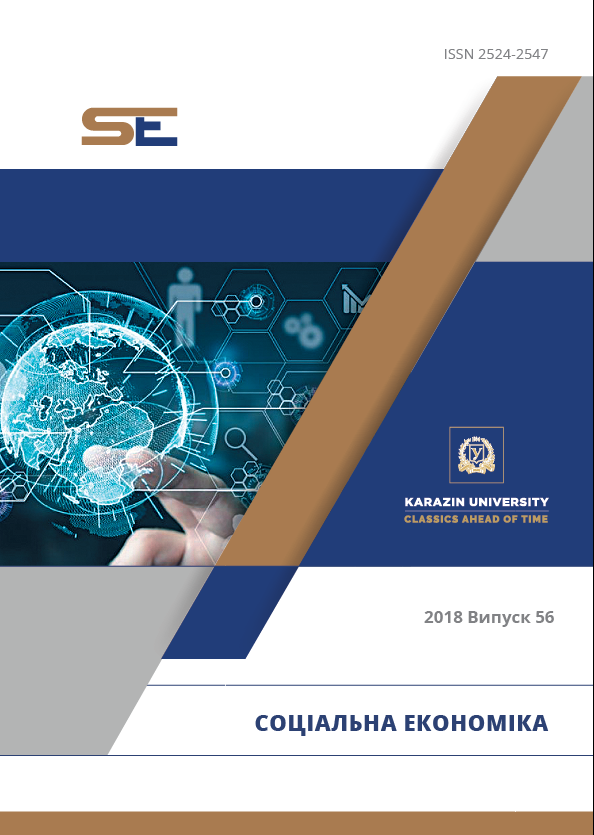Differentiation of Personnel Potential Management Methods of Enterprise
Abstract
The purpose of the article is to determine personnel potential management methods of enterprise taking into account the retrospective nature of the potential (acquired characteristics), its current state and characteristics, future capabilities and capabilities that will be necessary for sustainable development of the enterprise, and the formation of author’s vision of personnel management system at the enterprise by stages and in the context of management functions.
In the course of the study, it was founded that the personnel potential management of enterprise should begin at a stage before the establishment of official labor relations «employer-employee», because it is necessary to find and engage the future full-time worker of high qualification in the state of the enterprise, which refers to the personnel potential. The system of personnel potential management at enterprise is structured according to the management stage (before employment, employment, after employment). The change of the work itself, its transition from traditional to non-traditional ones, which is dominated by flexible structures, leads to the expansion of the concept «employee of the company» and management of combined labor force, when for the implementation of business tasks, the company involves not only staff members but also external sector experts, appears the so-called out-market of labor relative to a company that does not have the same external labor market to the fullest.
The expanded vision of systematization of personnel potential management methods at the enterprise was presented on the basis on belonging to management functions, adding motivational methods, since motivation is the basic control function. In addition, the grouping of methods by the nature of changes in the management system, which involves the allocation of innovative methods, supplemented by traditional, because, over time, each innovative method spreads into traditional. Two classification points were also introduced, according to which it is advisable to group methods by facet: depending on the manifestations of the potential, out-management methods (target future and past potential) and in-management methods (aimed at the present potential) were introduced.
Downloads
References
Shynkaruk, V. I. (2002). Philosophical encyclopedic dictionary [“Filosofskyi entsyklopedychnyi slovnyk”]. Kyiv: Abrys.
Strekhova, S. V. (2012). Interconnection and interdependence of elements of the personnel management system [“Vzaiemoziazok i vzaiemoobumovlenist elementiv systemy upravlinnia personalom”]. Aktualni problemy ekonomiky, 6(132), pp. 225‒233.
Kuzmin, O. Ye. and Melnyk, O. H. (2003). Fundamentals of Management [“Osnovy menedzhmentu”]. K.: Akademvydav.
Smachylo, V. V. (2017). Theoretical principles of structuring the personnel potential of the enterprise [“Teoretychni zasady strukturyzatsii kadrovoho potentsialu pidpryiemstva”]. Sotsialno-trudovi vidnosyny: teoriia ta praktyka: zb. nauk. Prats, 2(14), рp. 215‒225.
Kharun, O. A. (2016). Classification of methods for managing the labor potential of industrial enterprises [“Klasyfikatsiia metodiv upravlinnia trudovym potentsialom promyslovykh pidpryiemstv”]. [online] Available at: http://nbuv.gov.ua/UJRN/Nvuumevcg_2016_10%282%29_ _29 [Accessed 25 Nov. 2018].
Onyshchenko, E. (2012). Human Resources Management System: An Approach to Subsystem Design [“Systema upravlinnia kadrovym potentsialom pidpryiemstva: pidkhid do proektuvannia pidsystem”]. [online] Available at: http://visnykj.tneu.edu.ua/index.php/visnykj/article/view/408 [Accessed 24 Nov. 2018].
Korsakov, D. O. (2011). Organizational diagnostics of enterprise personnel management system. [“Orhanizatsiina diahnostyka systemy upravlinnia personalom pidpryiemstva”]. [online] Available at: http://www.ed.ksue.edu.ua/ER/RER/documents/blog.php?entry_id=1317157920 [Accessed 29 Nov. 2018].
Posheliuzhna, L. B. (2010). Features of modern personnel management at domestic enterprises [“Osoblyvosti suchasnoho upravlinnia personalom na vitchyznianykh pidpryiemstvakh”]. Innovative economy, 3, рр. 163‒166.
Lozynskyi, I. Ye. and Yelisieieva, L. O. (2012). Theoretical foundations of the personnel management system of the enterprise [“Teoretychni osnovy systemy upravlinnia personalom pidpryiemstva”]. Ekonomika i rehion, 3, pp. 184‒188.
Sardak, O. V. (2011). The position of marketing personnel in the management of employees of enterprises [“Pozytsiia personal-marketynhu v upravlinni pratsivnykamy pidpryiemstv”]. Ekonomichnyi analiz, 8, pp. 303‒307.
Rashytova, N. K. (2008). Methods and main functions of management activity [“Metody ta osnovni funktsii upravlinskoi diialnosti”]. Derzhavne budivnytstvo, 1. [online] Available at: http://nbuv.gov.ua/UJRN/DeBu_2008_1_8 [Accessed 25 Nov. 2018].
Lyzunova, O. M. and Ishchenko, Ya. H. (2018). Use of innovative methods of personnel management of the enterprise [“Vykorystannia innovatsiinykh metodiv upravlinnia personalom pidpryiemstva”]. Ekonomika i suspilstvo, 14. [online] Available at: http://economyandsociety.in.ua/ /journal/14_ukr/62.pdf [Accessed 29 Nov. 2018].
Ey.com. (2018). New Trends in Personnel Management: How to Build an Organization for the Future [“Novi trendy u sferi upravlinnia personalom: yak pobuduvaty orhanizatsiiu maibutnoho”]. [online] Available at: https://www.ey.com/ua/uk/newsroom/news-releases/news-ey-press-release-3-october-2018 [Accessed 25 Nov. 2018].
Smachylo, V. V. (2007). Regulation of working time as a component of non-material motivation [“Rehuliuvannia robochoho chasu yak skladova nemateryalnoi motyvatsii”]. Ukraina: aspekty pratsi, 8, pp. 49‒50.
Smachylo, V. V. (2017). Formation of personnel reserve of the enterprise as an element of social responsibility [“Formuvannia kadrovoho rezervu pidpryiemstva yak element sotsialnoi vidpovidalnosti”]. International Scientific and Practical Conference, pp. 113‒114.




